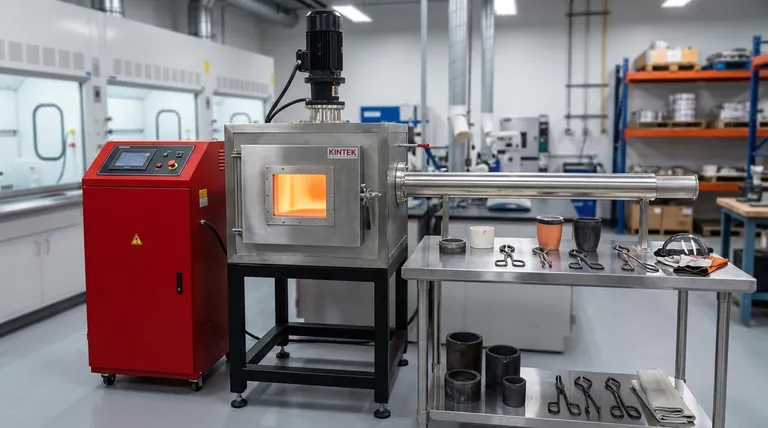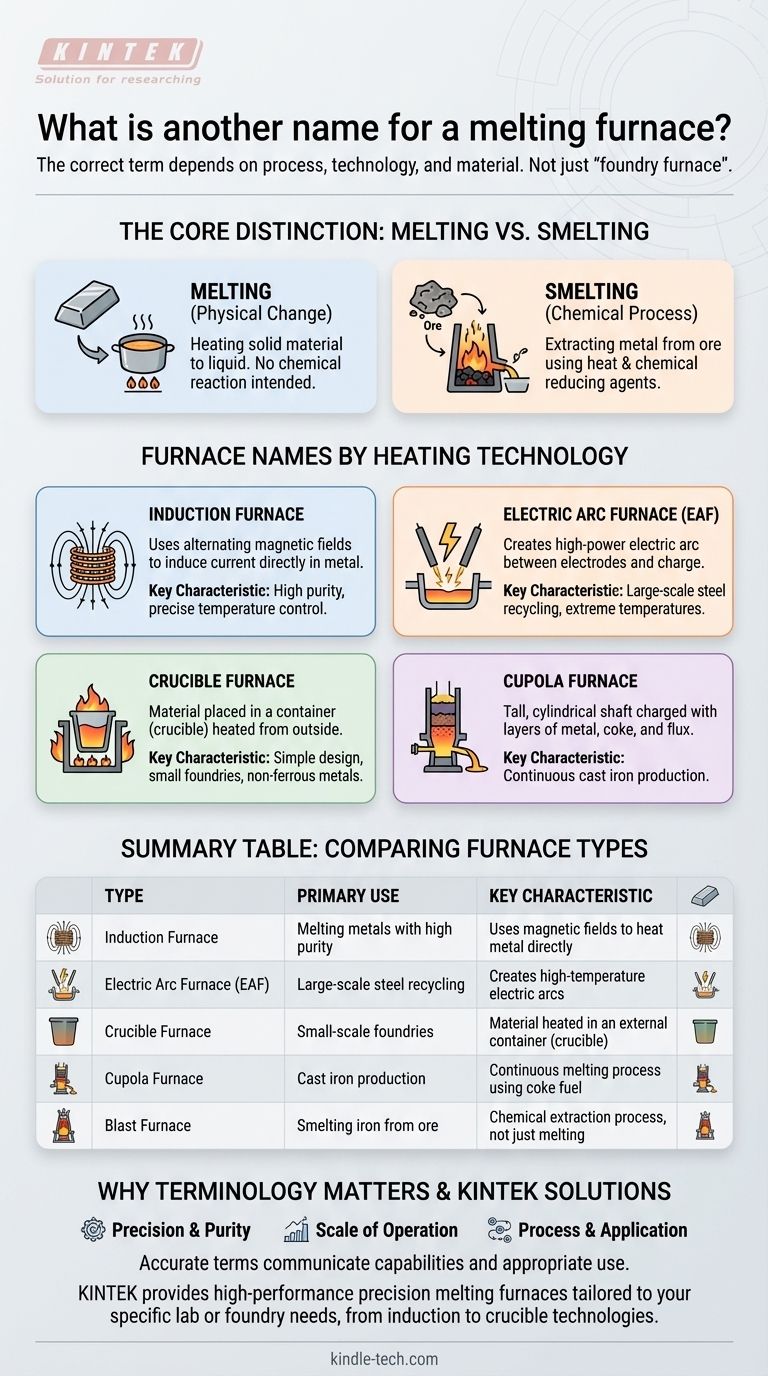In professional contexts, there is no single "other name" for a melting furnace. The correct term depends entirely on the specific process, the technology used to generate heat, and the material being melted. While a general term might be a "foundry furnace," more precise names like "induction furnace" or "electric arc furnace" are used to describe its function and design.
The term "melting furnace" is a broad descriptor. The specific, technically accurate name is determined by its heating method (e.g., induction, arc) or its chemical process (e.g., smelting), which reveals its true function and capabilities.

The Core Distinction: Melting vs. Smelting
Before exploring furnace types, it's crucial to understand the difference between two often-confused processes. This distinction is fundamental to using the correct terminology.
What is Melting?
Melting is a physical change of state. It is simply the process of heating a solid material, like a metal ingot, until it becomes a liquid. No chemical reaction is intended to happen.
What is Smelting?
Smelting is a chemical process used to extract a metal from its ore. It involves heating the ore to high temperatures with a chemical reducing agent, like carbon. Smelting includes melting as the extracted metal becomes liquid, but its primary purpose is chemical transformation.
A blast furnace used to make iron from ore is a smelting furnace. A furnace used to melt down aluminum scrap for recycling is a melting furnace.
Furnace Names Based on Heating Technology
The most common way to name a melting furnace in an engineering or foundry context is by the technology it uses to generate heat. This is the most precise and descriptive method.
Induction Furnace
This furnace uses alternating magnetic fields to induce an electric current directly within the metal charge. The metal's own electrical resistance generates intense, clean, and highly controllable heat.
Electric Arc Furnace (EAF)
An EAF melts metal by creating a high-power electric arc between graphite electrodes and the metal charge. This process generates extreme temperatures and is commonly used for recycling steel scrap on a massive scale.
Crucible Furnace
This is one of the simplest designs. The material is placed inside a container called a crucible, which is then heated from the outside by a flame (gas or oil) or electric elements. They are common in smaller foundries and for non-ferrous metals.
Cupola Furnace
A cupola is a tall, cylindrical shaft furnace that has been a workhorse for producing cast iron for centuries. It is charged with layers of metal, coke (fuel), and limestone (a flux) from the top and provides a continuous flow of molten metal from the bottom.
Why the Right Terminology Matters
Using the correct name is not just academic. It communicates critical information about the furnace's capabilities, scale, and appropriate use.
Precision and Purity
An induction furnace offers very high purity and precise temperature control, making it ideal for specialty alloys. A cupola furnace, which burns fuel in direct contact with the metal, is less controlled and introduces chemical changes, making it suitable for specific grades of cast iron.
Scale of Operation
The term "electric arc furnace" immediately implies a large-scale industrial operation, often melting over 100 tons of steel at a time. In contrast, a "crucible furnace" can be small enough for a hobbyist's workshop.
Process and Application
Calling something a "blast furnace" specifically signifies that its purpose is smelting iron ore. Referring to a "glass furnace" or "kiln" indicates it's designed for entirely different materials and temperature profiles than a metal furnace.
How to Apply This to Your Goal
Use the context of your work to select the most accurate and effective term.
- If your primary focus is general metal casting: "Foundry furnace" is a suitable and widely understood term.
- If you are extracting raw metal from ore: The correct term is "smelting furnace," with "blast furnace" being the most common type for iron.
- If you need to be technically precise for engineering or purchasing: Always use the name based on the heating technology, such as "induction furnace" or "gas-fired crucible furnace."
- If you are working with precious metals: Terms like "gold melting furnace" or "silver melting furnace" are common, as these are often small, specialized electric resistance or induction units.
Using the right name demonstrates a clear understanding of the process, technology, and purpose behind the equipment.
Summary Table:
| Furnace Type | Primary Use | Key Characteristic |
|---|---|---|
| Induction Furnace | Melting metals with high purity | Uses magnetic fields to heat metal directly |
| Electric Arc Furnace (EAF) | Large-scale steel recycling | Creates high-temperature electric arcs |
| Crucible Furnace | Small-scale foundries, non-ferrous metals | Material heated in an external container (crucible) |
| Cupola Furnace | Cast iron production | Continuous melting process using coke fuel |
| Blast Furnace | Smelting iron from ore | Chemical extraction process, not just melting |
Need the Right Furnace for Your Lab or Foundry?
Choosing the correct melting furnace is critical for the success of your process, whether you're working with precious metals, recycling scrap, or developing new alloys. KINTEK specializes in providing high-performance lab equipment, including precision melting furnaces tailored to your specific material and application needs.
We can help you:
- Achieve superior temperature control and purity for specialty alloys.
- Scale your operations with reliable and efficient melting solutions.
- Select the ideal technology—from induction to crucible furnaces—for your exact requirements.
Let's discuss your project. Contact our experts today to find the perfect melting furnace for your laboratory or production needs.
Visual Guide

Related Products
- Vacuum Induction Melting Spinning System Arc Melting Furnace
- Vacuum Heat Treat Furnace and Levitation Induction Melting Furnace
- 1700℃ Muffle Oven Furnace for Laboratory
- 1400℃ Laboratory Quartz Tube Furnace with Alumina Tube Tubular Furnace
- Laboratory Muffle Oven Furnace Bottom Lifting Muffle Furnace
People Also Ask
- What is RF magnetron sputtering? A Guide to Depositing Insulating Thin Films
- What is direct current DC magnetron sputtering? A Guide to High-Quality Thin Film Deposition
- What are the types of induction melting furnace? Coreless, Channel, and VIM Explained
- What is a sputtering machine? A Guide to High-Quality Thin Film Deposition
- What are sputtering systems used for? A Guide to Advanced Thin-Film Deposition



















